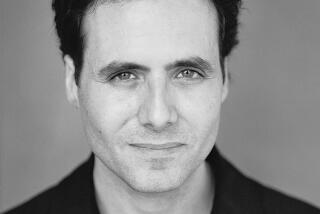The Silence of the Master : FROM HIROSHIMA TO GLASNOST At the Center of Decision--A Memoir <i> by Paul H. Nitze with Steven L. Rearden and Ann M. Smith (Weidenfeld Nicholson: $25; 504 pp. </i>
- Share via
This is a disappointing memoir of a long, admirable life in public service. Paul H. Nitze has been described by Strobe Talbott as the “master of the game,” but Nitze’s own book gives us little insight into what the game has meant for him or his country, or how it has changed over five decades. He calls himself an “uncommonly fortunate man in a troubled world,” and so he seems but not on the evidence of this book, which relegates business life and family to a kindly afterword.
Rather, it is a diary of 40 years of officialdom’s trench warfare. His tenacity comes through. So does his hurt pride, which can border on vindictiveness--when, for instance, he was passed over for high office by the Carter Administration. He responded by forming the Committee on the Present Danger, in part to hound the Administration that had spurned him.
Only occasionally does his passion break loose--for instance in describing the fate his colleague on the State Department Policy Planning Staff, John Paton Davies, suffered at Joseph McCarthy’s hands. More often the passion has to be discerned between the lines. Of John Foster Dulles, he says, “From several dealings with him on Wall Street . . . I had formed an unfavorable judgement of his character.” (He is more charitable with an antagonist still on the scene, Richard Perle, his bete noire during the Reagan Administration, admiring his “wit and intelligence despite the fact that he and I had tangled repeatedly over important policy issues.”)
Nitze had intended to return to Wall Street at the end of World War II, and he makes his decision to remain in government seem almost casual: His family wanted to remain in Washington, and “also, my basic thinking and interests, as a result of my various wartime experiences, had changed.” About why he gravitated from the economic issues that took much of his early years in government to military matters, he is equally terse: He declined President Kennedy’s offer to become undersecretary of state for economic affairs because he had become interested in “policy of a broader scope.”
The last third of the book deals with the questions that evidently were closest to his heart--and, implicitly at least, the ones he regarded as paramount--those of strategic nuclear weapons. His own post-mortem on Vietnam, rendered in a sentence, is nonetheless revealing: “The damage done to our position in the world and to our strategic nuclear capabilities in relation to the Soviet Union was incalculable.” From all the waste and killing, what mattered most was that the Soviet Union had stolen a strategic march on the United States.
The story of Nitze’s last assignments, in the Reagan Administration, is more revealingly told in Strobe Talbott’s book, “The Master of the Game: Paul Nitze and the Nuclear Peace.” In this instance, the game was tedious for all its high politics: For three long years, beginning when he was 78 years old, Nitze drafted and redrafted, named and renamed, argued and reargued schemes to persuade his President to have his cake and eat it too by reaching a modest compromise over SDI, the Strategic Defense Initiative, that would have made possible a major strategic arms reduction with Moscow.
I wish Nitze had taken us beyond tactical skirmishes to help us more in understanding what made him tick. The Cold War’s cold warrior, a principal architect of NSC 68 and the quadrupling of the defense budget during the Truman Administration, he became 30 years later the advocate of compromise over SDI. Before that in the Reagan Administration he was impelled to take the “walk in the woods” in search of an intermediate nuclear force agreement in Europe. Too circumspect or too polite, Nitze lays the failure of the “walk” entirely on Moscow’s delay in responding. Other accounts, however, including Talbott’s, also blame Washington’s guerrilla war over arms control and thus its unwillingness to pursue the “walk” formula.
Time has covered the first postwar decades with a gauze of bipartisanship that is misleading. The edges of partisanship are apparent not just between the lines of Nitze’s book but on them as well. Yet there was then a shared sense of purpose, and the men--there were as yet few women--who shaped foreign policy were linked in a much smaller Washington establishment through associations of family and school, and perhaps most important, through the intense experience of wartime and early postwar.
Now, by comparison, Washington’s foreign-policy establishment is much bigger, more open and thus more democratic but also more the target of interest groups and their lobbyists and probably less civil and more partisan as well. I wish Nitze had given us the benefit of his perspective on these changes. He hints that he regrets them. But why? Do they make for wiser policy or more stupid?
How well has America done in his decades of public service? Neither badly nor well, says Nitze; his evaluation runs from Korea to Vietnam in a short paragraph. Of the future he is hopeful, now that Reagan and Gorbachev have engaged their nations in serious arms control. Yet by what standard should we judge past or future? At what should we aim other than the next agreement, battles for which, Nitze tells us eloquently, will be longer and harder in Washington than between it and Moscow? And where might the United States, or he himself, have taken a more fruitful path? The book is little help in pondering these questions.
If Nitze had advantages, ones he does not deny, still his is a remarkable life in public service, the likes of which we will not see again. His upbringing was cosmopolitan, months spent in Europe. He had enough money at a young enough age that he could retire as a gentleman farmer and lick his wounds during the Eisenhower Administration while still in his 40s. It is hard to imagine that our own generation of Wall Street millionaires would have a vocation for public service or that we would want them in high office if they did. The recent renaming in his honor of the school Nitze helped found--the Johns Hopkins School of Advanced International Studies--is a fitting tribute to him.
More to Read
Sign up for our Book Club newsletter
Get the latest news, events and more from the Los Angeles Times Book Club, and help us get L.A. reading and talking.
You may occasionally receive promotional content from the Los Angeles Times.







